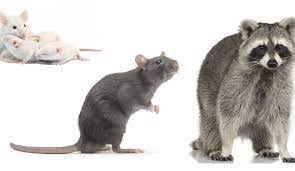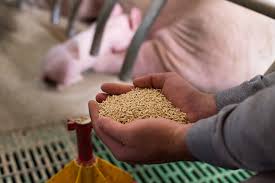Other Animal Pests of Crops and Their Control Measures
Animal pests other than insects include nematodes, mollusks, birds, monkeys, cattle and even man. In this article, focus is on rodents, birds and nematodes, because of their spread and importance.
1. Rodents
Rodents are pests of major importance. The rodents include rats, mice, rabbit, squirrel and beaver. These are animals that gnaw things their strong teeth especially adapted for the purpose.
In the field, rodents dig out, cut, and eat young plants and attack heads of cereals. In storage, they attack grains that have been threshed and stored, contaminate food with urine and faeces, damage furniture, fittings, equipment, cause water loss and serve as carriers of diseases, e.g. plague, typhus, jaundice and fever. Here, only rat and squirrel will be discussed.
1a. Rats
Damage done by rats depends on population, size and feeding habit. The rat population can increase very rapidly. Depending on availability of food, rat can breed throughout the year. Rats commonly found in buildings and habitations
Mastomysnatalensis(Multimammate rat) an M.erthroleous.These are also known as the ‘African house rat’. They are nocturnal, need food and shelter. They are found in the swamps of Lake Chad and the black soil plains where there is no vegetation in the dry season and they hide in deep cracks in the soil. They are serious pests of stored food.
Black/grey rat, ship – rat or roof – rat – Rattusrattus;
Brown Norway, or sewer rat – rattus nervegicus.
The domestic mouse – Musmusclulus–worldwide.
Important Species of Rats and their Damages in Crops
Arvicanthis nilitica (Nile harsh – furred rat) and A. abyssinicus. These are common in the Chad basin. Being diurnal, they avoid land without vegetation. They are found around river valleys and irrigated areas; rare in dry and sandy areas. They cause damage to cereals and dry season vegetables, cassava tubers and mango shoots.
Mastomysnatalensis(Multimammate rat) and M. erthroleous. These are also known as the ‘African house rat’. They are nocturnal, need food and shelter.
They are found in the swamps of Lake Chad and the black soil plains where there is no vegetation in the dry season and they hide in deep cracks in the soil.
They are serious pests of stored food. In the field, they dig out seeds, cut stems and eat grains of matured plants.
Taterillus spp. Found with Mastomys spp. in Lake Chad shore – line and also with Arvicanthis spp.in several river valleys. They did seeds at planting and groundnuts at ripening, and eat cowpea close to harvest.
Gerbillus spp. – Attained pests status at Nguru in 1975. Found to collect and store millet heads, groundnuts and seeds of okra, melons and calabash.
Tateraspp. – More numerous than before in some parts of the world.
T. Kembi (Kemb’s gerbil) is notorious for cutting young rice stems.
Cricetomys sp. – More numerous than before in some parts of the world.
C. gambianus (The giant pouch rat) has been captured in rice farms (though it does not damage rice crop much), store houses and domestic premises.
Thryonomys swinderianus (the cane rat). – Common where it is the main mammalian pest of rice crop.
Fex brush furred rat (Uranomys foxi), the pigmy rat (Mus muscoloides) and the spotted grass mouse (Lemniscomys striatus) are associated with rice farms. They dig and remove the planted seed.
Large Grey Dormouse (Graphiurus hueti), lives on trees and a major pest of cocoa.
Control Measures of Rats
a. Mechanical methods of control
Exclusion – Rat proofing of houses, warehouses, building, bins are very useful in preventing losses. Use of metal bins or tin containers for storing food is very effective.
Electric fence used at IRRI, Manila electrocuted some rats but it is not economical or feasible at most places. Many rats turn to unprotected fields.
Traps – Bow and arrow traps and spring (back – break) traps kill the rat, whereas various other traps, e.g. the wonder trap, will trap them alive. Traps are especially effective when food is scarce or bait more effective than the natural food is used. ‘Kosai’ may be more attractive than the grain or stems or other food in the habitat.
Communal drives to kill rats with sticks and knives are of value not only because they supplement the menu, but also because they add to millions of rats that were killed in the Philippines when all male citizens between 16 and 60 years of age were asked to go into “action”.
Bounties – Bounties offered for trails of rats raised public interest without adding much to control. The money is better spent on real control programme.
b) Biological control – snakes, foxes, jackals, hyenas, dogs, cats and weasels are natural enemies of rats and so are owls, falcons and hawks. Their numbers are going down due to hunting, killing, bush fires and environmental changes like cutting down of trees. Rat typhoid bacillus, Salmonella typhimurum was widely used in Japan to cause a fatal disease in rats, but is now prohibited.
c) Chemical Control Methods
i)Poison baits: Acute poison or single dose poison. E.g Zinc phosphide (0.75 – 3%), Thalium (Zelio grains) and Grimi (Sastrix grains). They are very popular for the control of rat. They are quick inaction and require single feeding.
Disadvantages:
Not all rats are killed.
Bait shyness develops after some time.
Secondary poisoning can occur.
Dangerous to man.
Must be distributed widely.
Chronic poison or multiple does poison. They are also called anticoagulants since they inhibit blood coagulation. Rat die of hemorrhage after 4 – 14 days as a result of the cumulative effect. The common chronic poisons used for rats are:
Warfarin 0.02%.
Read ALso : Damages Caused By Insect Pests and Importance Insect Pests of Major Crops
Chlorophacinone 0.005% (Rafia/Caid).
Coumachlor 0.025% (ratilan/Tomorin).
Diphacinone 0.005% (Ratak). In stores where food is plenty, these chemicals are better as liquid poison and care must be taken to make sure that only rats reach it.
1b. Squirrels
Two species of tree squirrel (Funisciurus snerythrus), a side stripped squirrel and the Gambian sun squirrel (Helioscirus gambianees) cause damage to oil palm, pawpaw and maize cobs in the field.
Others known to damage crops on farmlands are the Giant forest squirrel and the red legged ground squirrel. Squirrels also damage cocoa and rubber.
The control methods include the following:
Poisoning: This may not be suitable for tree squirrel because they are very sensitive, do not feed on harvested fruits or processed food. Camouflage and traps have been recommended for ground squirrel.
Use of repellant: These are however very expensive.
Trapping: Trapping using snares has been found to be effective against side – stripped squirrel and the Gambian sun squirrel. The method is cheap, efficient and free of dangers inherent in chemical control.
2. Nematodes
Nematodes or eelworms are minute, multi cellular animals that exist in all most every soil and water habitat of the world. In general, they are spindle – shaped, colourless, non – segmented roundworms.
Adult plant – parasitic nematode are comparatively small, 0.4 – 4mm long and 0.01 – 0.5mm in diameter. All plant – parasite nematodes possess a stylet – a hollow, protrusible, spear like structure located at the mouth entrance.
They stylet connects to the esophagus and is used for performing cell walls to inject digestive juices and for drawing nutrients.
Plant – parasitic nematodes are often classified by their feeding behaviour. Ectoparasites generally feed on cells near the surface and may inert portions of their heads into the plant tissue while they feed.

Endoparasites enter plants, lay eggs and feed in the plant tissues. Ectoparasites are generally larger than endoparasites. Nematodes may be classified as sedentary or migratory. Sedentary nematodes move within a host or between the host and the soil.
Nematode damage to field crops is often difficult to ascertain and may closely resemble or mimic response to drought stress, nutrient deficiencies, or other diseases and nutrient problems.
A typical symptom of nematode damage is irregular areas of varying size in which the plants have an unhealthy appearance. Heavily infected plants are smaller than normal plants, are usually chlorotic, and have a tendency to wilt because of reduced or unhealthy root system. Belo ground symptoms vary, depending on the specific nematodes attacking the roots.
The following symptoms are common:
Rootknotsor galls: Root tissue close to a nematode’s head often becomes enlarged bulbous and distorted.
Rootlesions: Root lesions develop when migratory endo – parasitic nematodes enter and move within the parenchyma cells of the host roots. As the nematodes feed, cavities develop, which may result in falling off of cortical tissue.
Small roots often become girdled by such injuries, so that root pruning occurs. Death necrosis of root tissue is often attributed to microorganisms that enter roots via wound caused by nematodes.
Abnormal or reduced root development: Ectoparqsitic nematodes normally feed on root tissue near the meristematic and cell – elongation regions. Damage to or death of root cells is primarily caused by the repeated probing of the stylet into the tissue. The plant then develops short thick tissues.
Control methods
Controlling nematodes is often complex and may not be justified unless the population exceeds the economic injury level for each nematode species.
Control measures should not be initiated without an accurate diagnosis to identify the species and determine the number of nematodes at the site. Nematode control may involve numerous strategies, including the following:
a. Quarantine and sanitation: The least expensive and most efficient means of nematode control is to prevent an infestation and build up. Transportation of soil, seed, debris and vegetative plant parts is the usual means of nematode dissemination.
b. Cultural practice: Plant – parasitic nematodes may be reduced to a low levels management and cultural practices, such as following crop rotation, timing of planting, providing optimum condition for plant growth, sanitation and the use of nematode – free planting stock. Tillage implements, by disturbing the soil, may effectively reduce various nematode species.
c. Physical treatments: Steam sterilization or hot water dips effectively control nematodes in small quantities of plant propagative material, seed and soil.
d. Biological control: Plant – parasitic nematodes are susceptible to predators and parasitic, including fungi, bacteria, insects and predacious nematodes. For small areas, mulching often promotes the buildup of biological – control organisms.
e. Use of resistant cultivars: The most effective and economic control is the use of nematode – resistant cultivars.
f. Chemical control: Insecticides – nematicides (carbonates and organophosphates) may be cost – effective if nematodes are implicated in crop losses.
3. Birds
These are the group of animals called aves. They are the most serious pests of cereals and fruits in the field. They attack cereals such as rice, millet and sorghum at the milk stage and after grain development.
They also use the leaves of cereals to make their nests thereby reducing the photosynthetic ability of plants. E.g. the village weaver and Quelea birds on grain crop. Their attack can lead to crop failure and increase the cost of production.
Birds can be controlled by the use of:
- Traps
- Scare crows
- Timely harvest of the crops
In summary, animals also constitute pests of major importance. For high productivity, they should be controlled, if not eliminated. Control methods may involve numerous strategies just as there are many animals.
Read Also : Complete Waste Management For Restaurants









